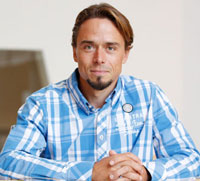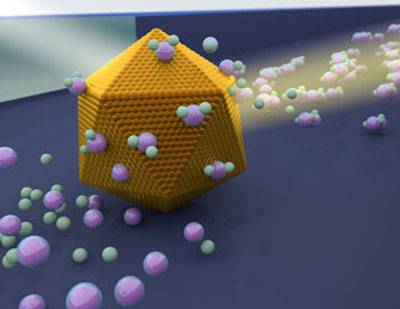| Posted: Oct 13, 2015 | |
Studies of individual nanoparticles can be the key to future catalysis(Nanowerk News) Studying catalytic processes on one single nanoparticle at a time, instead of on several billion simultaneously as has previously been the case, will create unique and more in-depth understanding of catalytic reactions on nanoparticles than previously possible – and it will at the same time lay the foundation for a new and sustainable energy technology and chemical synthesis. This is the point of departure for a five-year research project at Chalmers University of Technology that has been granted close to SEK 36 million from the Knut and Alice Wallenberg Foundation. |
|
 Christoph Langhammer "We want to produce an entirely new type of nanoreactor where it is possible to control the transport of liquid or gas to and from a single nanoparticle," says Christoph Langhammer, associate professor of chemical physics at Chalmers and one of the seven researchers who will conduct the project. The nanoreactor consists of a sealable channel with a diameter of under a hundred nanometers in which a single nanoparticle, whose size, shape and chemical composition have been tailored and analysed, will be enclosed. When a fluid containing reactant molecules is injected on one end of the channel it will interact with the catalyst nanoparticle, and the molecules that are created in that meeting will eventually emerge from the other end where they can be analysed. "The uniqueness of a nanochannel of this kind is that it collects and contains the product of a catalytic process that has taken place on one nanoparticle. Specifically, it concentrates the molecules that are formed into a volume that is tiny enough not to be diluted to the extent that they cannot be detected anymore. Thus it also assures that we really know that what comes out of the channel must have integrated with that specific nanoparticle and that we can analyse it. This also creates a direct link to quantum mechanical calculations, which are an integral part of the project, since they today also can be done in the basis of one nanoparticle. This will thus allow us to compare first principles calculations in a uniquely direct manner with our experiments." |
|
| Langhammer hopes that within five years the team will successfully have established the nanoreactor as an entirely new way to study catalytic processes. The fundamental understanding that will be obtained in this way can subsequently be significant when producing new materials to create a more environmentally friendly catalysis of industrial chemicals and fuels, which for example may reduce carbon dioxide emissions or other environmental pollutions. To reach this long-term goal, however, many small steps need to be taken. | |
 |
|
| Odd constellation | |
| "First we need to build new instruments and, for example, learn how to capture individual wet-chemically synthesised nanoparticles inside a nanochannel. This is a major challenge, and we will need to learn from our mistakes along the way. The fact that we have obtained funding for five years is critical, as well as the possibility to have a fairly large group of researchers with expertise in different fields to work together towards the same goals," says Langhammer. | |
| The other members of the team are Kasper Moth-Poulsen, Hanna Härelind, Anders Hellman, Fredrik Westerlund, Paul Erhart and Henrik Sundén, all from the physics, chemistry or biology departments at Chalmers University of Technology, and all of whom are around 35-40 years old. | |
| "We form an odd constellation in this context where KAW-projects are generally run by well-established senior researchers," says Christoph Langhammer. "We are, however, a group of highly motivated, fairly young researchers who will work as a team to conduct cutting edge research and to create a new experimental paradigm in catalysis science." |
| Source: By Karin Weijdegård, Chalmers University of Technology |
